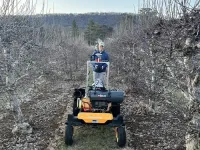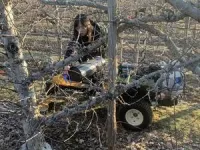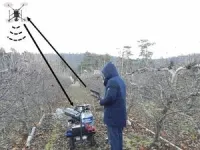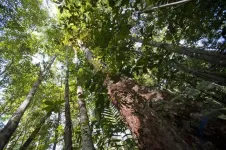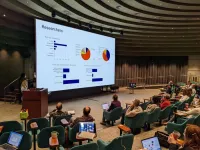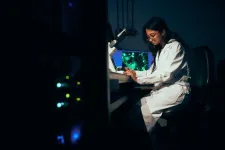(Press-News.org) UNIVERSITY PARK, Pa. — Spring frosts can have devastating effects on apple production, and a warming climate may be causing trees to blossom early, making them more susceptible to the damaging effects of extreme cold events. Growers’ attempts to prevent the flowers from freezing by attempting to heat the canopies of their orchards largely have been inefficient.
To deal with the worsening problem, Penn State researchers devised a frost protection cyber-physical system, which makes heating decisions based on real-time temperature and wind-direction data. The system consists of a temperature-sensing device, a propane-fueled heater that adjusts its direction and angle automatically depending on wind direction, and an unmanned ground vehicle to move the heating system through an apple orchard.
Recently published in Computers and Electronics in Agriculture, the findings show that the cyber-physical frost-protection system greatly reduced damage to apple tree buds in two tests conducted in low temperatures. Compared to similar unprotected orchard sections nearby, deploying the cyber-physical frost-protection system in one test more than doubled the time the test-area canopy was protected, and nearly tripled the time in another.
Applying heat is one of the most effective methods to prevent apple flower bud damage, however growers struggle to determine when and where to apply heat in their orchards, according to researcher Long He, assistant professor of agricultural and biological engineering, who is corresponding author on the study. They often don’t have an available labor force to accomplish the heating, he said, leading to either diminished apple crops or energy waste.
Growers know that apple flower buds can be damaged when the temperature falls below 30 degrees Fahrenheit, but they are deterred from taking active protective actions because wind can make heating efforts ineffective.
“Wind is often treated as an uncontrollable factor when growers are implementing heating tasks in orchards because it greatly affects heating performance,” He said. “To overcome the challenges growers face, we developed a system capable of monitoring the environment and taking actions in response to the monitored data, using temperature and wind sensors to perceive environmental changes and then make corresponding heating decisions.”
This study, which took place at Penn State’s Russell E. Larson Agricultural Research Center, was just the latest conducted by the research group focused on smart agriculture in the Department of Agricultural and Biological Engineering. First author Weiyun Hua, a graduate assistant, first determined heat-transfer patterns in an apple orchard utilizing images captured by an aerial drone-based thermal camera and a validated numerical model.
She then incorporated the findings of earlier published research, conducted by the group that created an algorithm to identify apple flower stages and developed a critical-damage temperature map that was made using an aerial drone-based camera. That research also used a drone-based thermal image camera to determine a temperature map, which was used to generate a heat-demand map. Hua used all that information to plan the path for the unmanned ground vehicle to accomplish heating tasks.
The total cost of equipment used to build the test unit in this study was approximately $5,000, Hua noted, mainly including the vehicle for $4,500, the heater for $200 and microcomputers for $100.
“Mostly, the parts were available off the shelf,” she said. “The unmanned ground vehicle is an electric lawnmower, with the seat and mower deck removed and the autonomous controls installed. The heater we used was a commercial heater, but it wasn't an orchard heater, it was an indoor space heater. So, the fabrication I did was primarily modifying small components to tie the system together.”
One especially innovative aspect of the system was the component Hua devised to automatically rotate and adjust the heater. The researchers learned from the developed numerical model that they needed to apply heat against the background wind direction to reduce heating loss from the orchard. And previous research had shown that an angle of 15 degrees — roughly pointing to the two on a clock face — between the heater outlet and the tree row provided maximum energy utilization.
“We wanted to make sure that the air temperatures got above those damaging critical temperatures for apple blossoms,” Hua said. “If the heater is pointed in a direction where it's flowing with the wind, the heat moves out of the orchard very quickly. But if we rotate it — so it's facing more into the wind — then the heat gets more widely distributed.”
Research team member Paul Heinemann, professor of agricultural and biological engineering in the College of Agricultural Sciences, noted that more research is needed to propel this technology into the marketplace and make it available to apple growers. But he said he believes this study shows proof of concept and demonstrates what is possible.
“One of the things that we got from this project is, if you had a very large orchard, you could have path-planning involving multiple units with multiple heaters running between the tree rows guided by an aerial drone monitoring the canopy temperatures,” he said. “The aerial drone would send a signal to a heating unit vehicle that says, ‘drive over to this place, because it's getting too cold there.’ And then it could tell a different heater unit to go to another spot. From the models, we know how much heat needs to be put in there, and how long it will take before it cools down again.”
That would ensure that there's no conflicts, preventing two units from going to the same place, Heinemann added.
“This research shows we can enhance the efficiency of using multiple heaters around an orchard, using less energy to heat but ensuring that we're hitting all the cold spots,” he said.
The U.S. Department of Agriculture’s Cyber Physical System Program and its National Institute of Food and Agriculture, and the U.S. National Science Foundation supported this research.
END
Cyber-physical heating system may protect apple blossoms in orchards
Research suggests autonomous, intelligent system is capable of warming fruit tree canopies, preventing frost damage
2024-02-29
ELSE PRESS RELEASES FROM THIS DATE:
NYC ranks safest among big US cities for gun violence, new research from NYU Tandon School of Engineering reveals
2024-02-29
New York City ranks in the top 15 percent safest of more than 800 U.S. cities, according to a pioneering new analysis from researchers at NYU Tandon School of Engineering, suggesting the effectiveness of the city’s efforts to mitigate homicides there.
In a paper published in Nature Cities, a research team explored the role that population size of cities plays on the incidences of gun homicides, gun ownership and licensed gun sellers.
The researchers found that none of these quantities vary linearly with the population size. ...
A landmark study maps the precise orchestration of prenatal development
2024-02-29
In a landmark study, researchers at University of Washington and The Jackson Laboratory have characterized, in exacting detail, the rapid series of events that transform a single fertilized cell into a living, complex being. The work, reported this month in Nature, not only has enabled the team to explore which genes drive the differentiation of hundreds of cell types, but also shows, for the first time, that there are very rapid changes in genetic activity within the hour immediately following birth, underscoring the speed with which newborns must adapt.
“The ...
Unveiling rare diversity: the origin of heritable mutations in trees
2024-02-29
Tropical trees are at the heart of this study. They are essential for climate regulation, maintaining biodiversity and providing crucial resources for many local communities. Understanding how they evolve genetically is therefore of vital importance for preserving biological diversity and finding sustainable solutions for tropical forest adaptation to the environmental pressures they face.
The aim of this study was to identify the mutations accumulated during growth by two specimens of tropical trees sampled in French Guiana, a French overseas department covered to 96% by tropical forest. To do this, the scientists ...
Tandem cycling linked to improved health for those with Parkinson’s, care partners
2024-02-29
EMBARGOED FOR RELEASE UNTIL 4 P.M. ET, THURSDAY, FEBRUARY 29, 2024
MINNEAPOLIS – Pedaling on a stationary bicycle built for two may improve the health and well-being for both people with Parkinson’s disease and their care partners, according to a small, preliminary study released today, February 29, 2024, that will be presented at the American Academy of Neurology’s 76th Annual Meeting taking place April 13–18, 2024, in person in Denver and online.
“Our study found that a unique cycling program that pairs people with Parkinson’s disease with their care partners can improve ...
Preprints raise possibility of rethinking the peer-review process as they become more widely used and accepted
2024-02-29
Preprints raise possibility of rethinking the peer-review process as they become more widely used and accepted – new article encourages their growing momentum and provides recommendations to empower researchers to provide open and constructive peer review for preprints
#####
In your coverage, please use this URL to provide access to the freely available paper in PLOS Biology: http://journals.plos.org/plosbiology/article?id=10.1371/journal.pbio.3002502
Article Title: Recommendations for accelerating ...
A new channel for touch
2024-02-29
Every hug, every handshake, every dexterous act engages and requires touch perception. Therefore, it is essential to understand the molecular basis of touch. “Until now, we had known that the ion channel – Piezo2 – is required for touch perception, but it was clear that this protein alone cannot explain the entirety of touch sensation,” says Professor Gary Lewin, head of the Molecular Physiology of Somatic Sensation Lab at the Max Delbrück Center.
For over 20 years Lewin has been studying the molecular basis of the sensation ...
Scientists identify new ‘regulatory’ function of learning and memory gene common to all mammalian brain cells
2024-02-29
Johns Hopkins Medicine neuroscientists say they have found a new function for the SYNGAP1 gene, a DNA sequence that controls memory and learning in mammals, including mice and humans.
The finding, published March 1 in Science, may affect the development of therapies designed for children with SYNGAP1 mutations, who have a range of neurodevelopmental disorders marked by intellectual disability, autistic-like behaviors, and epilepsy.
In general, SYNGAP1, as well as other genes, control learning and memory by making proteins that regulate the strength of synapses — the connections between brain ...
Ultraviolet “winds” erode a young star’s protoplanetary disk in Orion Nebula
2024-02-29
Ultraviolet “winds” from nearby massive stars are stripping the gas from a young star’s protoplanetary disk, causing it to rapidly lose mass, according to a new study. It reports the first directly observed evidence of far-ultraviolet (FUV)-driven photoevaporation of a protoplanetary disk. The findings, which use observations from the James Web Space Telescope (JWST), provide new insights into the constraints of gas giant planet formation, including in our own Solar System. Young low-mass stars are often surrounded by relatively short-lived protoplanetary disks of dust and gas, which provide the raw materials from which planets ...
Pelagic fish more impacted by human pressures and protections than benthic species
2024-02-29
Pelagic fish – species that occupy the water column of the open ocean, neither near the bottom nor near the shore – are more impacted by both human pressure and protection than bottom-dwelling benthic species, researchers report. The findings highlight the need for increased marine protection in remote pelagic locations. Body size is a universal biological property that influences a range of ecological processes in marine ecosystems. Measuring body-size-structured variation can be a useful framework for understanding and predicting the impacts of overfishing or the success ...
Climate change is altering the seasonal pattern of river flow globally
2024-02-29
Climate change is altering the seasonality of river flow, particularly at high northern latitudes, according to a new study. Patterns in river flow vary with the seasons – a cycle that plays a critical role in floods and droughts, water security, and the health of biodiversity and ecosystems worldwide. Although recent studies have shown that climate change has already altered river flow seasonality (RFS), much of the evidence is limited to local regions or fails to consider the impact of climate change explicitly, independent of other human impacts to river flow. Consequently, the impact of climate warming on RFS isn’t ...
LAST 30 PRESS RELEASES:
Doing good pays off: Environmentally and socially responsible companies drive value and market efficiency
City of Hope and Cellares to automate manufacturing of solid tumor CAR T cell therapy
Short-circuiting pancreatic cancer
Groundbreaking mapping: how many ghost particles all the Milky Way’s stars send towards Earth
JBNU researchers propose hierarchical porous copper nanosheet-based triboelectric nanogenerators
A high-protein diet can defeat cholera infection
A more accurate way of calculating the value of a healthy year of life
What causes some people’s gut microbes to produce high alcohol levels?
Global study reveals widespread burning of plastic for heating and cooking
MIT study shows pills that communicate from the stomach could improve medication adherence
Searching for the centromere: diversity in pathways key for cell division
Behind nature’s blueprints
Researchers search for why some people’s gut microbes produce high alcohol levels
Researchers find promising new way to boost the immune response to cancer
Coffee as a staining agent substitute in electron microscopy
Revealing the diversity of olfactory receptors in hagfish and its implications for early vertebrate evolution
Development of an ultrasonic sensor capable of cuffless, non-invasive blood pressure measurement
Longer treatment with medications for opioid use disorder is associated with greater probability of survival
Strategy over morality can help conservation campaigns reduce ivory demand, research shows
Rising temperatures reshape microbial carbon cycling during animal carcass decomposition in water
Achieving ultra-low-power explosive jumps via locust bio-hybrid muscle actuators
Plant-derived phenolic acids revive the power of tetracycline against drug-resistant bacteria
Cooperation: A costly affair in bacterial social behaviour?
Viruses in wastewater: Silent drivers of pollution removal and antibiotic resistance
Sub-iethal water disinfection may accelerate the spread of antibiotic resistance
Three in four new Australian moms struggle with body image
Post-stroke injection protects the brain in preclinical study
Cardiovascular risk score predicts multiple eye diseases
Health: estimated one in ten British adults used or interested in GLP-1 medications for weight loss
Exercise to treat depression yields similar results to therapy
[Press-News.org] Cyber-physical heating system may protect apple blossoms in orchardsResearch suggests autonomous, intelligent system is capable of warming fruit tree canopies, preventing frost damage
